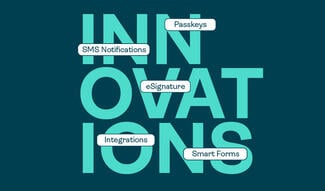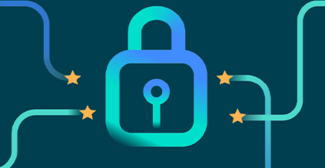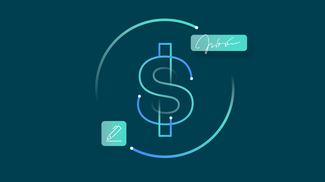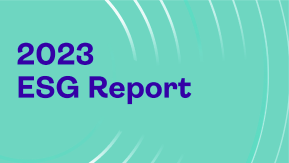How to evaluate eSignature pricing
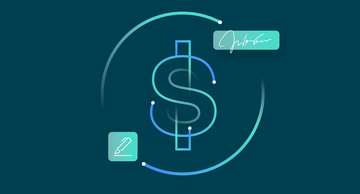
Small businesses and enterprises alike see the value in electronic signature software, such as OneSpan Sign, Adobe Sign, DocuSign, PandaDoc, and SignNow. Moving to a fully digital workflow to sign documents electronically benefits the entire organization, streamlines the signature process, and addresses document management. What's more, organizations can embed eSignatures and digital signatures into PDF documents, making it easy to send and receive signature requests to recipients anywhere, at any time.
Many organizations often start with small or internal signing processes, such as HR hiring and onboarding, to test the electronic signature software’s capabilities, work out any kinks, and prove the value. From there, the goal is to extend eSignatures across the company over time. Naturally, once they scale, their eSignature usage grows. The greater the number of users, signers, and documents, the more eSignature pricing will change.
That is why it’s important to look for a vendor that offers a transparent, flexible eSignature pricing structure that evolves with you. You don’t want to be locked into something that doesn’t make sense long term, or be faced with billing surprises, additional costs, or "gotcha pricing" at renewal. In this blog, we'll review common pricing models in the market as well as important considerations as you evaluate electronic signature pricing.
Pricing models
- • Seat-based pricing: The software is sold as one license per user. Some electronic signature vendors put a limit on the number of transactions per seat, while others don’t.
- • Capacity-based pricing: This is also known as band pricing. This pricing provides flexibility, within a band of transaction volume, to pay the same price without needing to know exact number of transactions to be purchased. However, the risk is being charged additional fees once the set number of transactions is consumed.
- • Consumption-based pricing: Per transaction pricing with price breaks once certain thresholds are met. Typically, this pricing requires organizations to forecast the precise number of transactions to purchase to receive the best pricing options.
- • Enterprise license: An enterprise license is a flat price, with no limit on how many transactions you can use.
How you use eSignatures matters
When evaluating the cost of a solution, you understandably want to know the variety of pricing models and formats the vendor provides. Some questions to consider include:
- Does the vendor offer eSignature pricing based on the number of documents? Is it based on a per package, per transaction, or per user/seat basis? Or is it a flat annual all-in-one fee for unlimited documents? Are there volume discounts available for larger commitments?
- Do you need standard/basic or premium features? Basic plans may include standard eSigning capabilities, while premium tiers add advanced features, like workflow automation, custom branding, API access, or advanced authentication methods. Are there vendors that offer premium features as part of the basic plans, or will this require an upgrade?
- Are integrations available? Seamless integration with existing tools, like HR platforms, CRM systems, or productivity and storage software, might involve additional costs.
- What is the price and level of support? Are there dedicated account managers, 24/7 support, or implementation assistance?
- What is the vendor’s policy on pricing changes? Can you secure pricing protection? Understanding the vendor's approach to price stability is crucial, especially for organizations seeking predictability in budgeting over time.
- Does the vendor provide the flexibility to scale up or down easily? Can you align costs with your growth trajectories?
- Does the vendor provide industry-specific compliance requirements (e.g., ESIGN, UETA, GDPR, eIDAS, HIPAA)? Will you need to pay for enhanced security measures, such as multifactor authentication (MFA) or audit trails?
There’s no one-size-fits-all solution, so the answer depends on how you will consume eSignatures. Document signing transactions are either sender-led or system-initiated (i.e. fully automated), so understanding your needs is the first step. Then, you can determine pricing for the options available.
Sender-led processes
Sender-led processes are the fastest way to start using electronic signatures because you log in to the service only when you need it, or when it’s a pre-integrated connector that initiates eSignatures directly from other platforms, like Workday, Salesforce, and SharePoint.
Both options are ideal for small to mid-sized companies, as well as individual departments and workgroups within larger organizations (especially if IT resources are limited or you need to go live immediately).
If you intend to move to customer-facing, high-volume processes with full automation in the future, starting with an eSignature service is advantageous because it allows you to test your volumes before committing to a price. If this is something you are considering, ask the vendor if their service includes the same core features and capabilities as the full platform.
Learn more about the OneSpan Sign Professional Plan for sender-led processes:
Fully automated processes
Fully automated processes, on the other hand, are high-volume, repeat processes with customers. These documents are automatically generated by the system, such as a banking or insurance portal or a business mobile app. They are fully automated and seamlessly integrated with core systems, so there is no manual work needed to prepare documents for signature. Examples include insurance applications, loan applications, finance contracts, new account agreements, and government permits.
In this scenario, the pricing can be either per transaction or blocks of transactions at a fixed price. The possible catch, however, is that when you first start out with eSignatures, you don’t necessarily know what the user adoption and volumes will be.
That’s why you need to look for an eSignature vendor that is flexible and allows you to test user adoption over a period of time and adjust your needs accordingly. The vendor should work with you to find a pricing structure that is fair for everyone, whether that’s capacity-based (pricing flexibility based on a band of transaction volume), consumption-based (per-transaction pricing with discounts after meeting certain thresholds), or seat-based.
Learn more about the OneSpan Sign Enterprise Plan for integrated deployments:
Understanding price per value
Electronic signature pricing shouldn’t be difficult for organizations to figure out. You want to find a vendor that will provide you with the highest return on investment (ROI), leading to higher conversions and ensuring that you get more value for your money. This is what OneSpan Sign offers. In fact, an auto insurance carrier shared that, beyond improved completion rates for online applications and claims, they were pleased to find that OneSpan Sign was “less than half the price of Docusign.”
In addition to understanding how you’re using eSignatures with your organization, here are three other factors to consider when it comes to evaluating the cost of an eSignature solution.
1. Features costs: eSignature solutions come with various features and functionality. Ask the vendor how they price the solution and if you need to pay added fees for additional capabilities. For example, are authentication features and third-party connectors included with the base plan?
Generally speaking, the more regulated and complex your signing workflows, the more features and functionality you need. Look for solutions that allow you to customize workflows and the application's look and feel, as well as strong audit trail capabilities to demonstrate compliance.
It’s also important to choose an eSignature provider that charges one price for their entire set of features and functionality. This has a big impact on your bottom line if you plan to roll eSignatures out across your operations down the road. The last thing you want is an eSignature provider that nickels and dimes you for every feature.
2. Scaling costs: Another important consideration is the cost of scaling and managing eSignatures across your operations and different lines of business. IT and internal policies change frequently, so implementing an electronic signature solution with rich automation capabilities, bulk send, and reusable templates can help you keep signing processes for digital documents lean.
3. Customer service costs: You want a solution that allows you to digitize your agreement processes and ensures you’re maximizing completion rates. Understand what customer service looks like with your vendor to determine how they can support your needs as you grow and evolve. Look for a vendor who has a vested interest in partnering with you.
eSignature pricing: The bottom line
When an eSignature provider is truly invested in your success and wants to form a long-term relationship with your organization, they will do what it takes to ensure you are equipped with a cost-effective solution.
That begins with an understanding that your needs will change as your organization grows and evolves. The right vendor will provide you with high-quality service, fast implementation, and strong product functionality at a competitive price.
